Kay Susan. Reward Intermediate. Communicative activities for students of English
Подождите немного. Документ загружается.


•
What
went
wrong?
Reward
Intermediate
Resource
Pack
fold fold
......................................
,.r,
!!!!!!!!!!!!!!!!!!!!!!!!!!!!!!!!!!!!!!!!!!!!!!!!!!!!~
.....
!!!!
...
!!!!!!
.....
!!!!!!
.....
!!!!!!
.....
!!!!!!.
~~
...
.....
~
.....
!!!!!!
••..
!!!!!!
.....
!!!!!!
-----v
-----v
------)C
------)C
gotsunbumt
? ..................................................
,,,
..
,,
.to
..........
.................
,
•••.
"
...........
"
....
"
...
:
.............................
"
.......
"
...................
1
•••••••••
,
..................................
,
•••••••••
" •••
------v
------v
------)C
------)C
got
bored
on
the
beach
bad
money
stolen
",
...
!
........
,·····
..
··•·········•
..
,················,·········1····
...
..................
,
..........
,
........................
,,,
.........................
,,
..........
',,,
....
,
......
,:
-----v
-----v
------)C
------)C
hotel
room
noisy
rained
every
day
'
••••
0
....
'
•••••••
,
........................
",
••••
"
.........
,
•••••
",
...........
",
.....
,
•••
,
.......................
,
•••
,',
•••••••
"
..............
,
............................................
'.,
••••••••••••
,
••••
,
.......
,
••
------v
------v
------)C
------)C
lost
passport
suitcase
too
heavy
............................................,
.........
·························r····························.......................
..........................................
,
-----v
-----v
------)C
------)C
too
hot
..
"
....
"
...........
,
......
,................
",
....
,
.....
,
....
,",
....
,
..
, ................,
....
,
.......
, ..........................., ..,
...
, ..............................."
............
,
....
,
.....
"
CI
Susan
Kay.
1995. Published
by
Heinemann English Language Teaching.
This
sheet may
be
photocopIed
and
used wahin the class,
went
sightseeing
-
got
lost
didn't
understand
the
language
......
"','
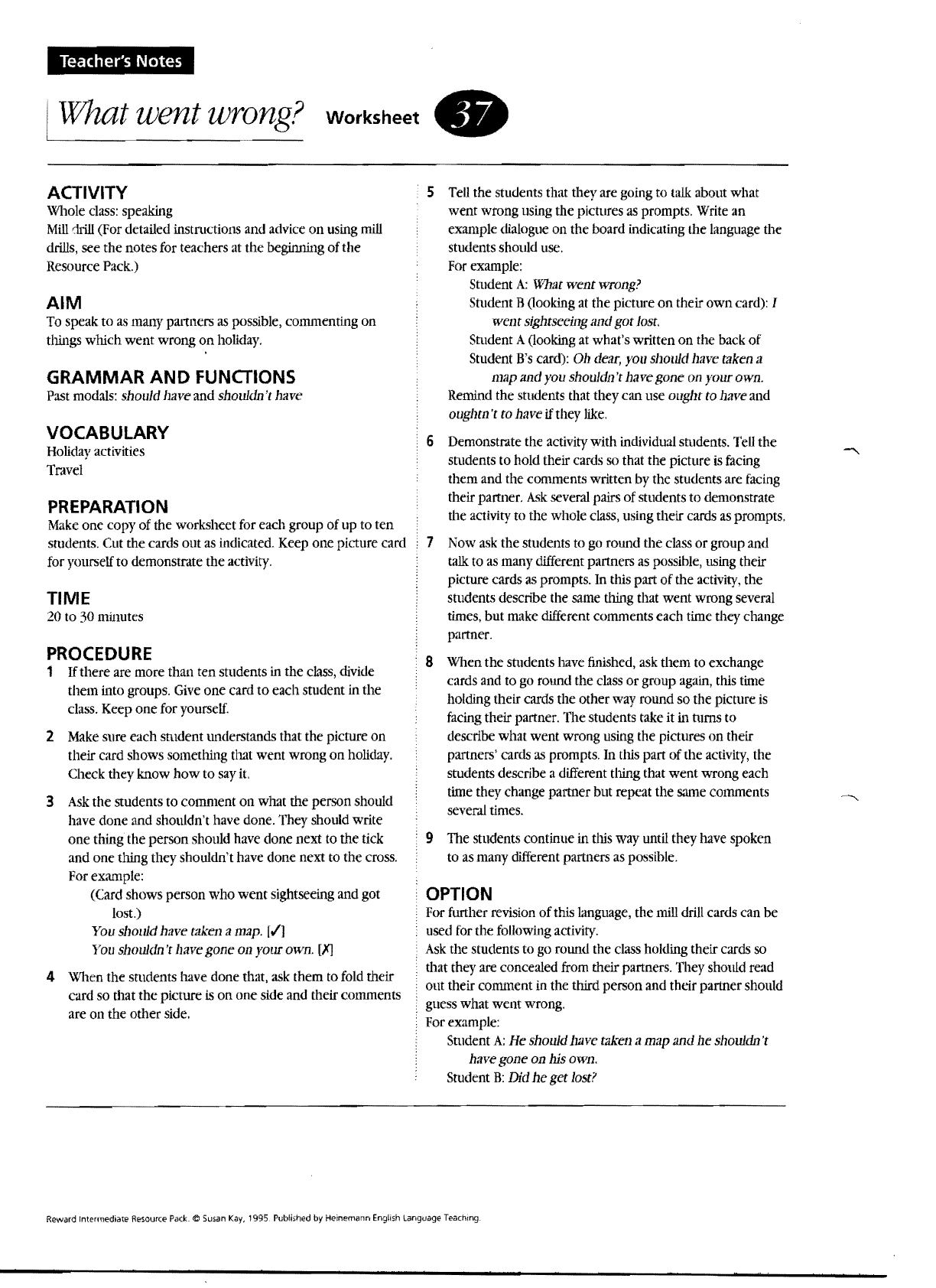
Teacher's Notes
I
What
went
wrong?
Worksheet •
ACTIVITY
Whole
class:
speaking
Mill
drill
(For detailed instructions
and
advice
on
using
mill
drills,
see the notes
for
teachers
at
the beginning of the
Resource
Pack.)
AIM
To
speak
to
as
many partners
as
possible, commenting on
things which went wrong on
holiday.
GRAMMAR
AND
FUNCTIONS
Past
modals:
should
have
and shouldn't
have
VOCABULARY
Holiday
activities
Travel
PREPARATION
Make
one copy of the worksheet
for
each group of
up
to
ten
students.
Cut
the cards out
as
indicated.
Keep
one picture card
for yourself to demonstrate the
activity.
TIME
20
to
30
minutes
PROCEDURE
1
If
there
are
more than ten students
in
the
class,
divide
them into groups.
Give
one card
to
each student
in
the
class.
Keep
one for
yourself.
2
Make
snre each student understands that the picture on
their card shows something that went wrong on
holiday.
Check they know how to
say
it.
3
Ask
the students
to
comment on what the person should
have
done and shouldn't
have
done. They should write
one thing the person should
have
done next
to
the tick
and
one thing they shouldn't
have
done next
to
the
cross.
For
example:
(Card
shows person who went sightseeing and got
lost.)
You
siwuld
have
taken
a
map.
[.I]
You ShOllldn't
have
gone
on
your own. [X]
4 When the smdents
have
done that,
ask
them
to
fold
their
card
so
that the picture is on one side
and
their comments
are
on the other
side.
5
TeU
the students that they
are
going
to
talk
about what
went wrong
using
the pictures
as
prompts.
Write
an
example dialogue on the board indicating the
language
the
students should
use.
For
example:
Student
A:
W11ac
went
wrong?
Student B (looking
at
the picture on their own card): 1
wem
sightseeil1g
and got
lost.
Student A (looking
at
what's written on the
back
of
Student
B's
card): Dh
dear,
YOll should
have
taken
a
map
and
you
shouldn't
have
gone
on
your own.
Remind
the students that they can
use
oUght
to
have
and
oughtn't to
have
if
they
like.
6 Demonstrate the
activity
with
individual
students.
TeU
the
students
to
hold their cards
so
that the picture is
facing
them and the comments written
by
the students
are
facing
their partner.
Ask
several pairs of students
to
demonstrate
the
activity
to the whole
class,
using their
cards
as
prompts.
7
Now
ask
the students
to
go
round the
class
or group and
talk
to
as
many
different partners
as
possible,
using
their
picture cards
as
prompts.
In
this part of the
activity,
the
students describe the
same
thing that went wrong
several
times,
but
make
different comments each time they change
partner.
8 When the students
have
finished,
ask
them
to
exchange
cards
and
to
go
round the
class
or group
again,
this
time
holding their
cards
the other
way
round so the picture
is
facing
their partner. The students
take
it
in
turns
to
describe what went wrong
using
the pictures on their
partners'
cards
as
prompts.
In
tIlis
part of the
activity,
the
students describe a different
tl1ing
that went wrong each
time
they change partner but repeat the
same
comments
several
times.
9 The students continue
in
this way until they
have
spoken
to
as
many
different partners
as
possible.
OPTION
For
further
revision
of
this
language,
the
mill
drill
cards can be
used
for
the
following
activity.
Ask
the students to
go
round the
class
holding their cards
so
that they
are
concealed
from
their partners. They should read
out their comment
in
the third person and their partner should
guess what went wrong.
For example:
Student
A:
He
shmdd
i11lve
taken
a
map
and
he
shouldn't
have
gone
on
his OWll.
Student
B:
Did he get
lost?
Reward
Intermediate
Resource
Pack.
©
Susan
Kay,
1995
Publis~ed
by Heinemann
English
language
TeachIng.
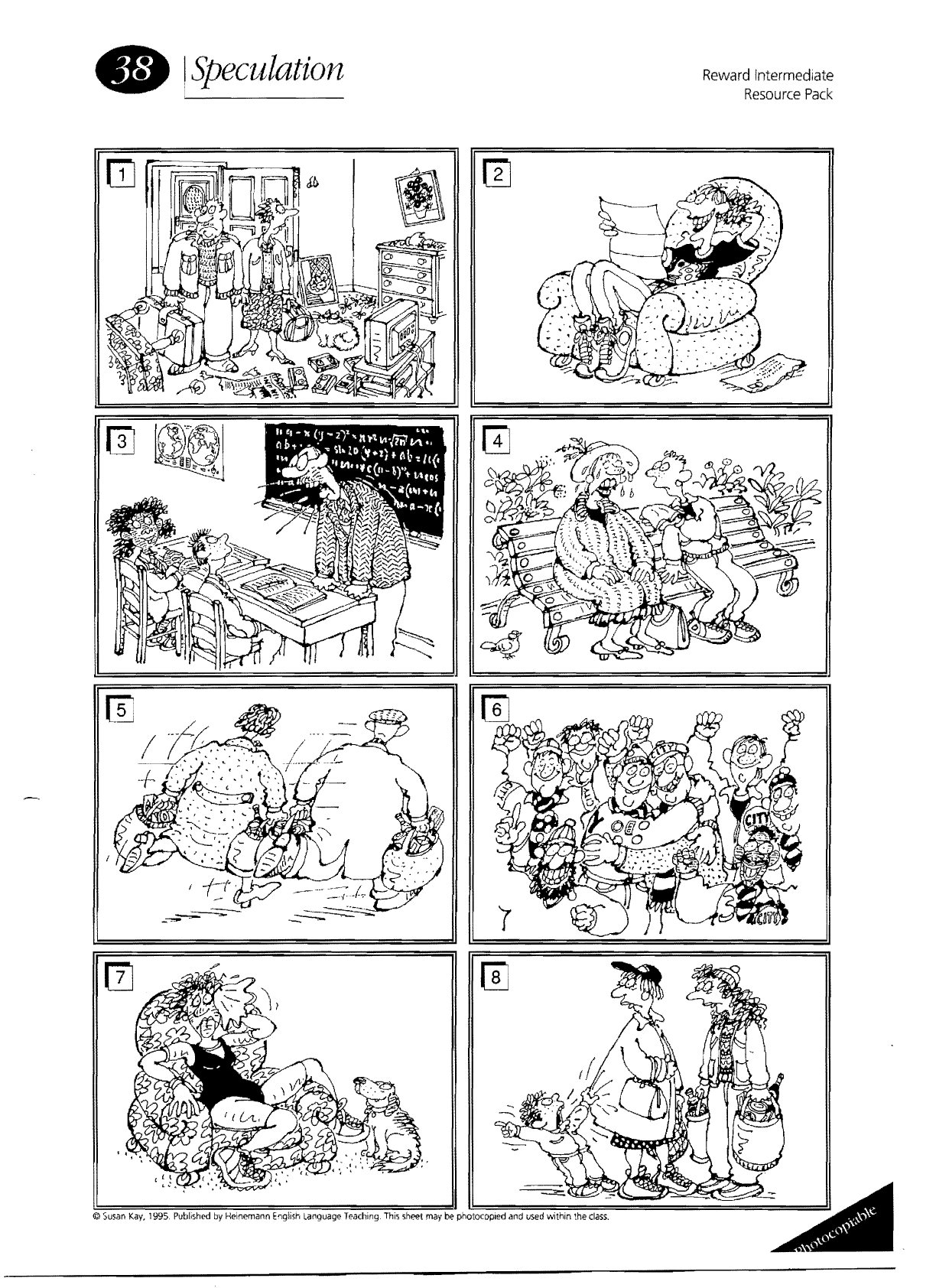
Reward
Intermediate
• I
Speculation
Resource
Pack
rn
©
Susan
Kay,
1995.
Published
by
Heinemann
bgiish
Language Teaching.
This
sheet
may
be
photocopIed and used
within
the
class.
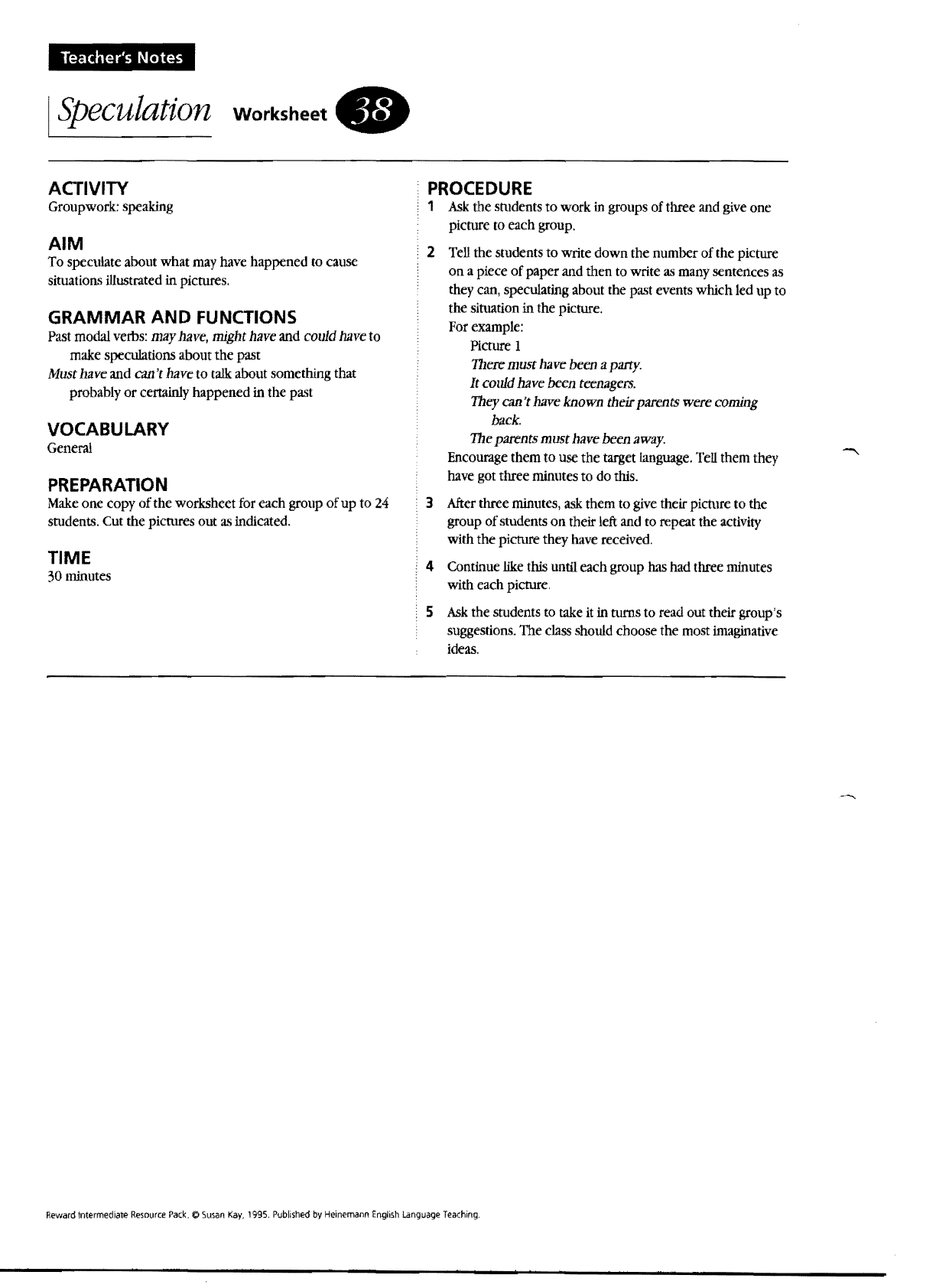
Teacher's Notes
[Speculation
worksheet.
ACTIVITY
Groupwork: speaking
AIM
To
speculate about what may have happened to cause
situations illustrated in pictures.
GRAMMAR
AND
FUNCTIONS
Past modal verbs: may
have,
might
have
and
could
have
to
make speculations about
the
past
Must
have
and can't
have
to
talk about something that
probably
or
certainly happened in the past
VOCABULARY
General
PREPARATION
Make
one
copy
of
the worksheet for each group
of
up
to
24
students. Cut the pictures
out
as
indicated.
TIME
30 minutes
PROCEDURE
1
Ask
the students
to
work in groups
of
three and give one
picture
to each group.
2 Tell the students
to
write
down
the number
of
the picture
on
a piece
of
paper and
then
to write as many sentences as
they can, speculating about the past events
which
led up
to
the situation in the picture.
For example:
Picture
1
There must
have
been
a
party.
It
could
have
been
teenagers.
They
can't
have
known
their
parents
were
coming
back.
The
parents
must
have
been
away.
Encourage
them
to
use
the
target language. Tell them they
have got three minutes
to
do
this.
3 After three minutes, ask them
to
give their picture
to
the
group
of
students
on
their left and to repeat the activity
with
the
picture they have received.
4 Continue like this until each group
has
had three minutes
with each picture.
S
Ask
the students to take
it
in turns
to
read out their group's
suggestions. The class should choose the most imaginative
ideas.
Reward
Intermediate
Resource
Pack.
e
Susan
Kay,
1995.
Published
by
Heinemann
E~glish
Language
Teaching.
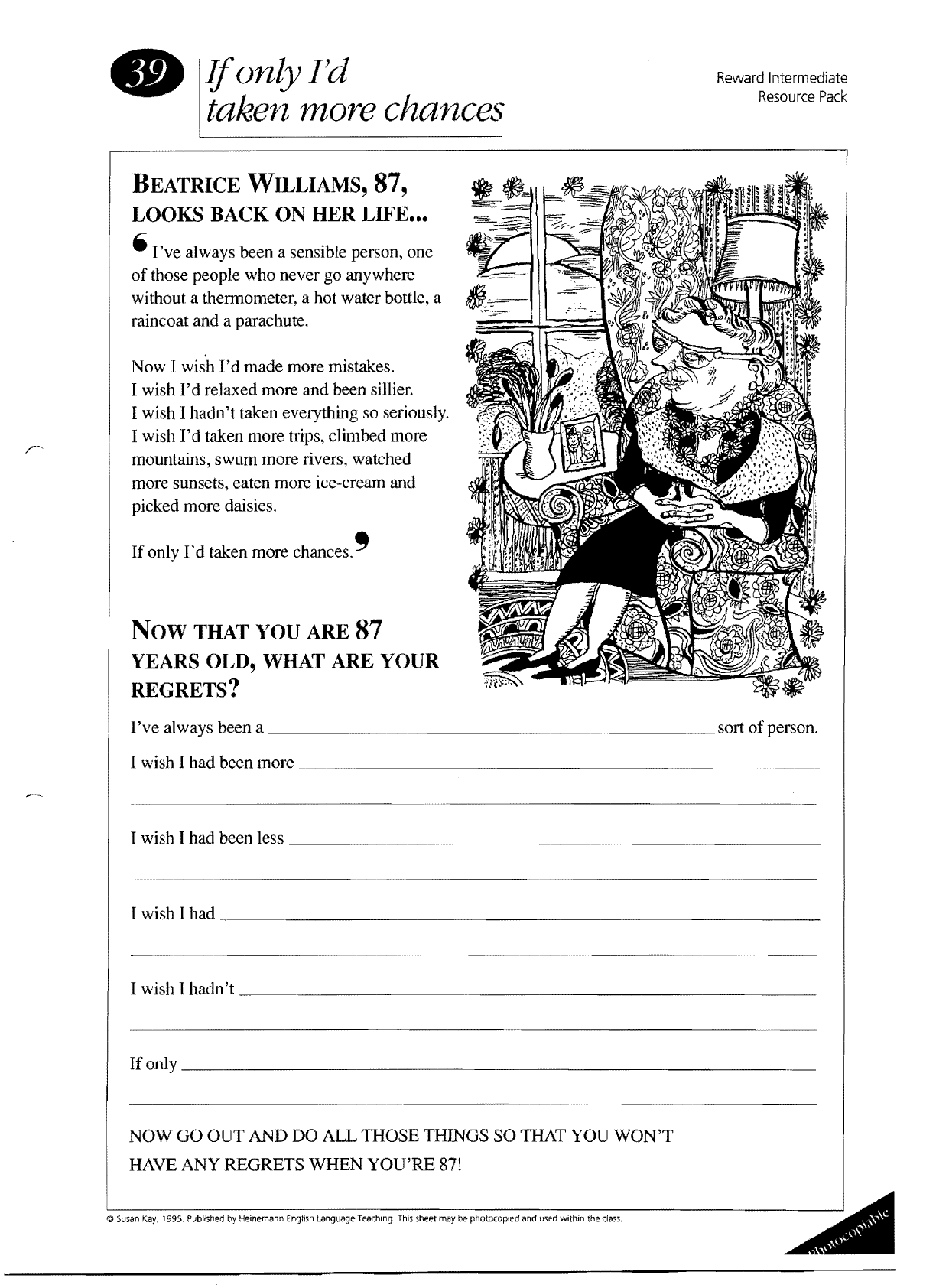
i
•
Ifonly
]Jd
Reward
Intermediate
Resource
Pack
taken more chances
BEATRICE
WILLIAMS,
87,
LOOKS BACK ON HER LIFE
...
I've
always been a sensible person, one
of
those people who never go anywhere
without a thennometer, a hot water bottle, a
raincoat and a parachute.
Now I wish 1'd made more mistakes.
I wish
I'd
relaxed more and been sillier.
I wish I hadn't taken everything so seriously.
I wish
I'd
taken more trips, climbed more
mountains, swum more rivers, watched
more sunsets, eaten more ice-cream and
picked more daisies.
If
only
I'd
taken more
chances.~
Now THAT YOU ARE
87
YEARS OLD, WHAT ARE YOUR
REGRETS?
I've
always been a
______________________
sort
of
person.
I wish I had been more
__________________
_
I wish I had been less
_______________
_
I wish
Ihad
__________________________________
__
I wish I hadn't
____________
..
________________
_
Ifonly
____________________________
___
NOW
GO
OUT AND DO ALL THOSE THINGS SO
THAT
YOU
WON'T
HAVE ANY REGRETS WHEN
YOU'RE
87!
©
Susan
Kay,
1995.
Published
by
Heinemann
English
Language
Teaching.
ThiS
sheet
may
be
photocopied
and
used
within
the
class.
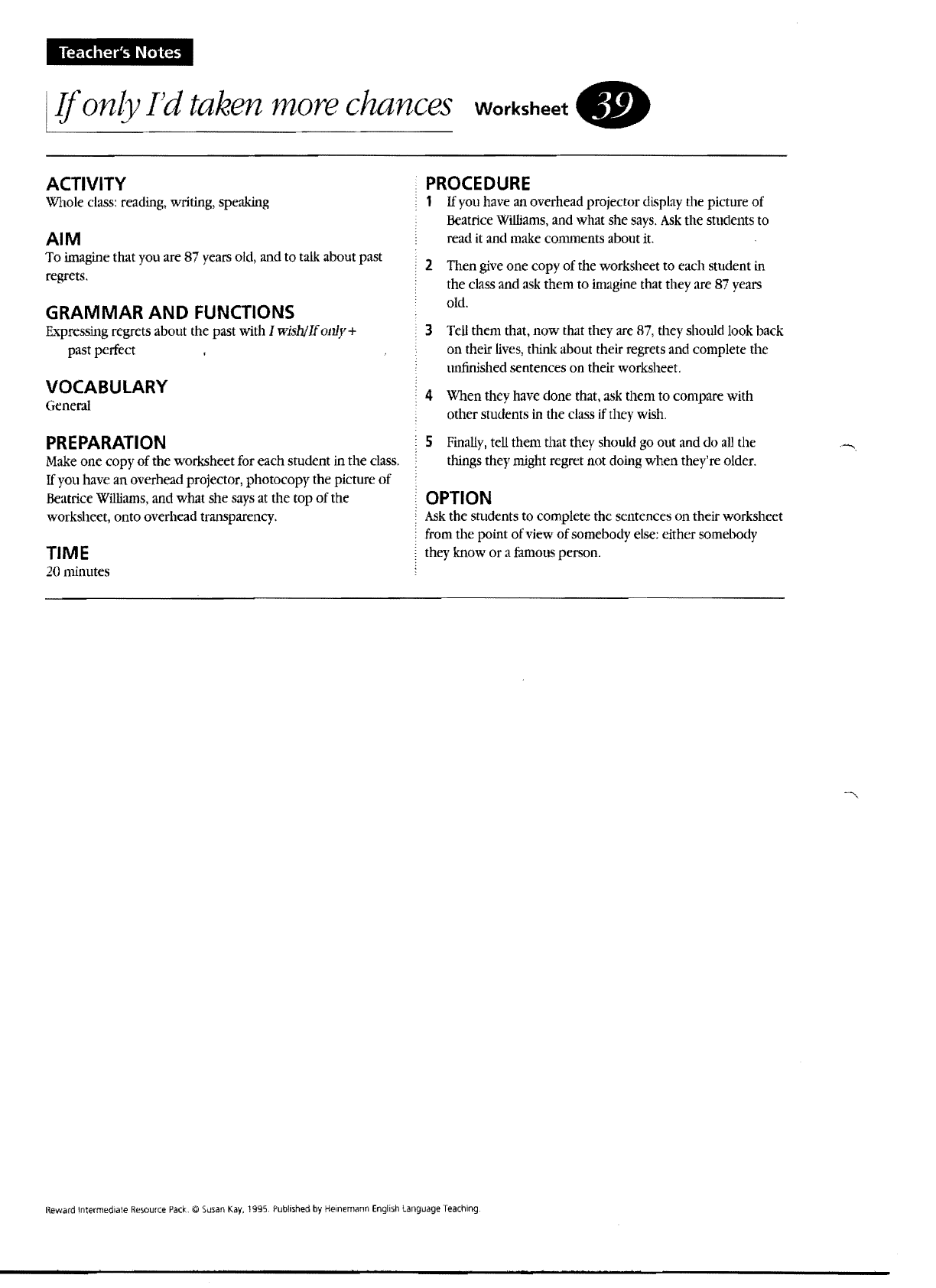
Teacher's
Notes
I
if
only
I'd
taken
more
chances
worksheet.
ACTIVITY
\Vhole class: reading, writing, speaking
AIM
To imagine that you are
87
years old, and to talk abollt past
regrets.
GRAMMAR AND
FUNCTIONS
E.xpressing regrets about the past with I wish/If
01111'+
past perfect
VOCABULARY
General
PREPARATION
Make one copy
of
the worksheet for each student in
the
class.
If
you have an overhead projector, photocopy the picture
of
Beatrice Williams, and what she says
at
the top
of
the
worksheet, onto overhead transparency.
TIME
20 minutes
PROCEDURE
1
If
you have an overhead projector display the picture
of
Beatrice
WtIliams,
and what she
says.
Ask
the students to
read
it
and make comments about it.
2 Then give
one
copy
of
the worksheet to each student in
the class and ask them to inlllgine that they are 87 years
old.
3 Tell them that,
now
that they are 87, they should look back
on
their lives, think about their regrets and complete the
unfinished sentences on their worksheet.
4 When they have done that, ask them to compare with
other students in the class
if they wish.
5
Finally,
tell them that they should go out and do
all
the
things they might regret not doing
when
they're older.
OPTION
Ask
the smdents to complete the sentences
on
their worksheet
from the
point
of
view
of
somebody else: either somebody
they know
or
a famous person.
Reward
Intermed,ate
Re;ource
Pack.
©
Susan
Kay.
1995.
Published
by
Heinemonn
English
language
Teaching

Reward
Intermediate
• I
Imagine
Resource
Pack
""
.......
""
..
",
...
"
..
.,
....
"
If
I hadn't come here today, I would have ...
If
I
hadn't
decided
to
learn English, I would
have ...
_____________
_
If
I'd had
time
this
week. I would have ...
If
I had been born a
member
of
the
opposite
sex.
I would have ... _
.....................................
_____
_
If
I had followed
my
parents advice I would
have ...
____
..........
________
_
If
I'd won
the
lottery recently, I would have
...
",.,',.,
...
,",
.........
,",
....................
,."
.....
,.,
....
".",.
......
"
..
If
I'd found £1
00
on
my
way here today,
I would have ...
__________
_
If
I'd
met
an alien
from
outer space on
my
way here today, I would have ...
___
_
If
J'd
gone
to
a party last
night
I would have
If
I had been born a
member
of
the
opposite
sex,
my
parents would have
..............
~
___
_
If
I had
met
my
great-great-grandparents,
I would have ...
__
.~
....
_
.....
________
..
If
I'd lived before, I would have been ...
©
Susan
Kay,
1995.
Published
by
Heinemann
English
Lar;9uage
Tea(hn9.
This
sheet
may
be
photocopied
and
used
Within the
class.
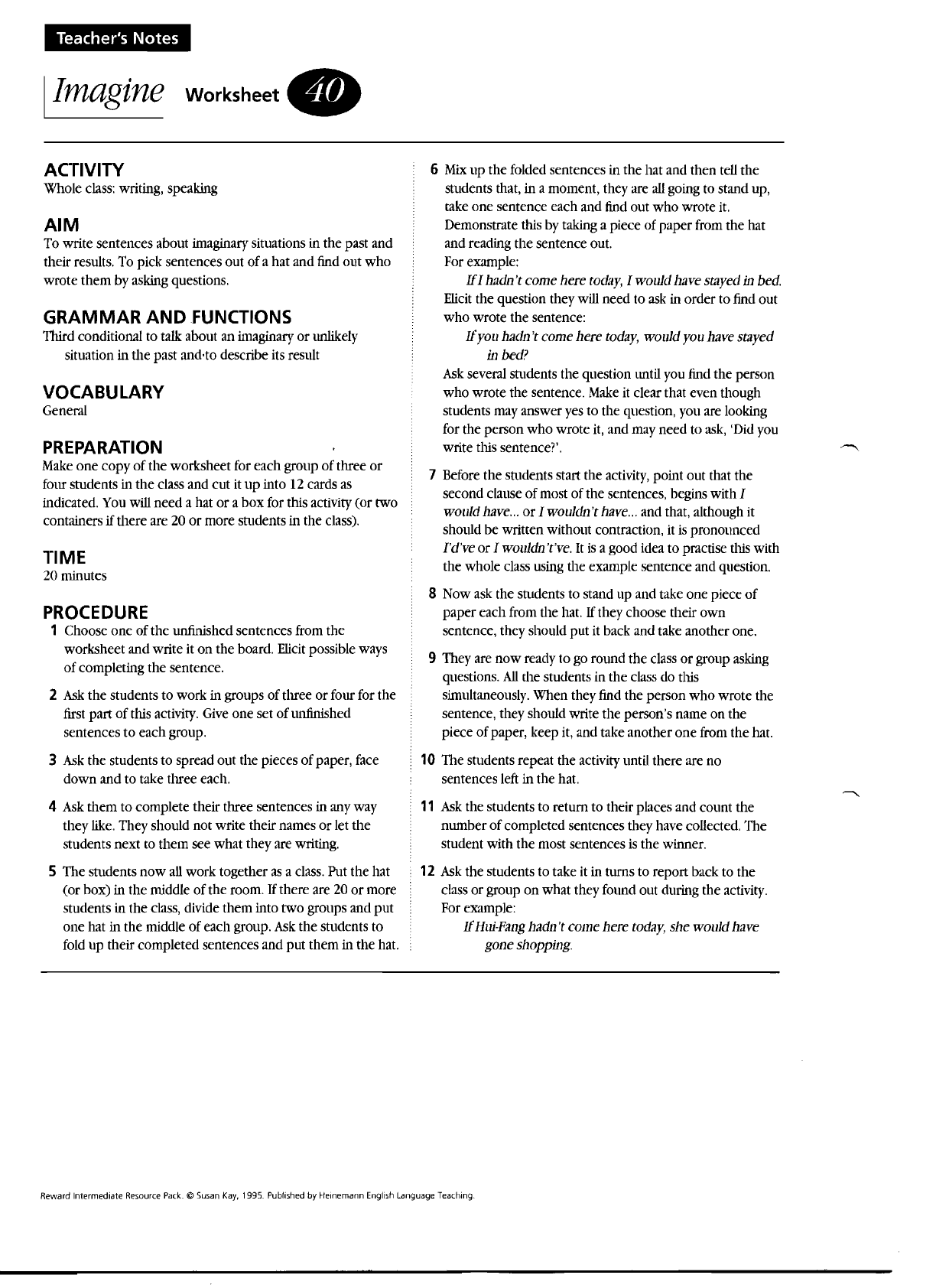
Teacher's Notes
I
Imagine
workSheet.
ACTIVITY
Whole class: writing, speaking
AIM
To write sentences about imaginary situations in
the
past and
their results. To pick sentences out
of
a hat and find
out
who
wrote
them
by asking questions.
GRAMMAR
AND
FUNCTIONS
11lird conditional to talk about an imaginary
or
unlikely
situation in
the
past and,to describe its result
VOCABULARY
General
PREPARATION
Make
one
copy
of
the
worksheet for each group
of
three
or
four students in
the
class and
cut
it
up
into 12 cards as
indicated. You will
need
a hat
or
a
box
for this activity
(or
two
containers
if
there
are 20
or
more students in the class).
TIME
20 minutes
PROCEDURE
1 Choose
one
of
the
unfinished sentences from
the
worksheet and write it
on
the board. Elicit possible ways
of
completing
the
sentence.
2 Ask
the
students
to
work
in groups
of
three
or
four for
the
first part
of
this activity. Give
one
set
of
unfinished
sentences
to
each
group.
3 Ask the students to spread
out
the pieces
of
paper, face
down
and to take three each.
4 Ask
them
to
complete their three sentences in any way
they
like. They
shOUld
not write their names
or
let
the
students
next
to
them
see
what
they are writing.
S
The
students
now
all
work
together
as
a class. Put
the
hat
(or
box) in
the
middle
ofthe
room.
If
there are 20
or
more
students in
the
class, divide
them
into
two
groups and
put
one
hat in the middle
of
each group. Ask
the
students to
fold
up
their completed sentences and
put
them
in
the
hat.
6
Mix
up
the
folded sentences in
the
hat and
then
tell
the
shtdents that, in a moment, they are
all
going to stand up,
take
one
sentence each and find out
who
wrote
it.
Demonstrate this by taking a piece
of
paper
from
the
hat
and reading the sentence out.
For example:
If
I hadn't
come
here
today,
I wOllld
have
stayed
in
bed.
Elicit the question they will need to ask in
order
to find
out
who
wrote
the
sentence:
If
YOll
hadn't
come
here
today,
wOllld YOll
have
stayed
in
bed?
Ask
several shtdents the question lmtil you find
the
person
who
wrote
the sentence. Make
it
clear that even though
students may answer yes to the question, you are looking
for the
person
who
wrote
it, and may
need
to ask, 'Did you
write this sentence?'.
7 Before
the
shtdents start the activity, point
out
that
the
second clause
of
most
of
the
sentences, begins
with
I
wOllld
have
...
or
I wOllldn 't
have
...
and that, although it
should
be
written without contraction, it
is
pronounced
[,d've
or
I wOllldn 't've.
It
is
a good idea
to
practise this with
the
whole class using the example sentence and question.
S
Now
ask the students to stand up and take
one
piece
of
paper
each from the hat.
If
they choose their
own
sentence, they should
put
it back and take another one.
9 They are
now
ready to go round
the
class
or
group asking
questions.
All
the students
in
the
class do this
simultaneously.
When
they find
the
person
who
wrote
the
sentence, they should write
the
person's name
on
the
piece
of
paper, keep it, and take another
one
from
the
hat.
10
The students repeat the activity until there are no
sentences left in the hat.
11
Ask the students to return to their places and
count
the
number
of
completed sentences they have collected. The
student
with
the
most sentences
is
the
winner.
12
Ask
the
students to take it in turns to report back to
the
class
or
group
on
what
they found out during the activity.
For example:
If
Hili-Fang hadn
'f
come
here
today,
she
wOllld
have
gone shopping.
Reward Intermediate Resource
Pack.
© Susan
Kay.
1995. Published
by
Heinemann
English
Language Teaching.
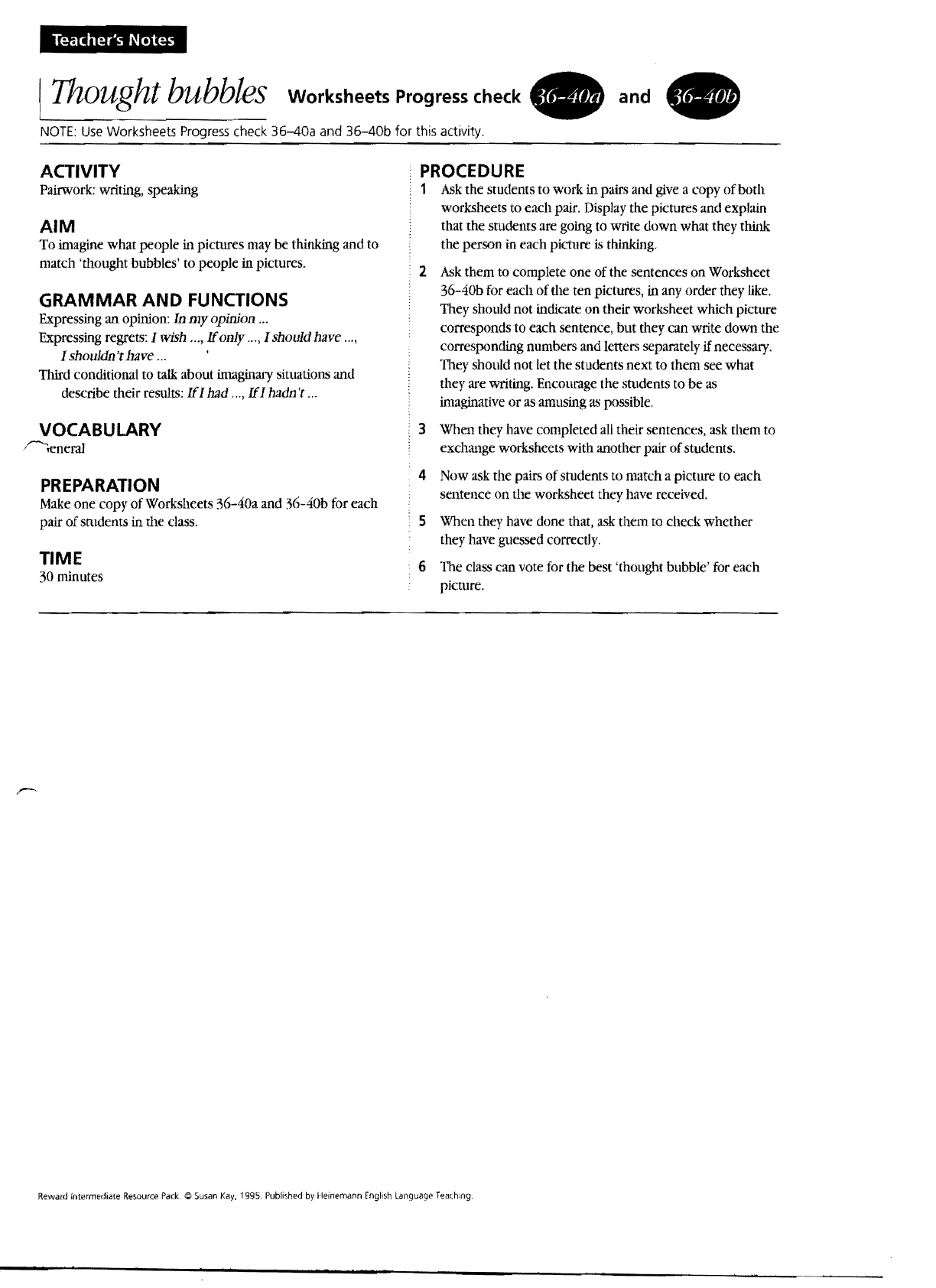
Teacher's
Notes
I
Thought
bubbles
Worksheets
Progress
check
and.
NOTE:
Use
Worksheets Progress check
36-40a
and
36-40b
for
this activity.
ACTIVITY
Pairwork:
writing, speaking
AIM
To
imagine
what people
in
pictures
may
be thinking and
to
match 'thought bubbles' to people in pictures.
GRAMMAR
AND
FUNCTIONS
Expressing an opinion:
In
my
opinion
...
Expressing
regrets:
I
wish
...
,
Ifonly
...
, I should
have
...
,
J shouldn't
have
...
Third
conditional to
talk
about imaginary situations and
describe their
results:
If
J
had
...
,
If
J
hadn
'f
...
VOCABULARY
~,eneraI
PREPARATION
Make
one copy of Worksheets 36-40a
and
36-40b
for
each
pair of
sUldents
in the
class.
TIME
30
minutes
PROCEDURE
1
Ask
the students to work
in
pairs
and
give
a copy of both
worksheets
to
each
pair.
Display
the pictures
and
explain
that the students
are
going
to
write down what they think
the person
in
each picture is
thinking.
2
Ask
them
to
complete one of the sentences on
Worksheet
36-40b
for
each of die ten pictures,
in
any
order they
like.
They
should not indicate on their worksheet which picture
corresponds
to
each sentence, but they can write down the
corresponding numbers
and
letters separately
if
necessary.
They
should not let the studenrs next
to
them
see
what
they
are
writing.
Encourage
the students
to
be
as
imaginative
or
as
amusing
as
possible.
3 When they
have
completed
all
their sentences,
ask
them
to
exchange worksheets with another pair of students.
4
Now
ask
the
pairs
of students
to
match a picture
to
each
sentence on the worksheet they
have
received.
5 When they
have
done that,
ask
them
to
check whether
they
have
guessed correctly.
6
The
class
can vote
for
the
best
'thought bubble'
for
each
picture.
Reward
Intermediate
Resource
Pack.
©
Susan
Kay.
1995.
Published
by
Heinemann
English
language
Teaching.

Progress
check
Reward
Intermediate
Resource
Pack
~
I
Thoughtbubbks
•
"iii
11
I~I~----~--------_
i--------i
[II
©
Susan
Kay,
1995
PublIShed
by
Heinemann
English
language
Teaching.
Tn;,
sheet
may
be
phDtDcopied
and
used
within
the
class.
